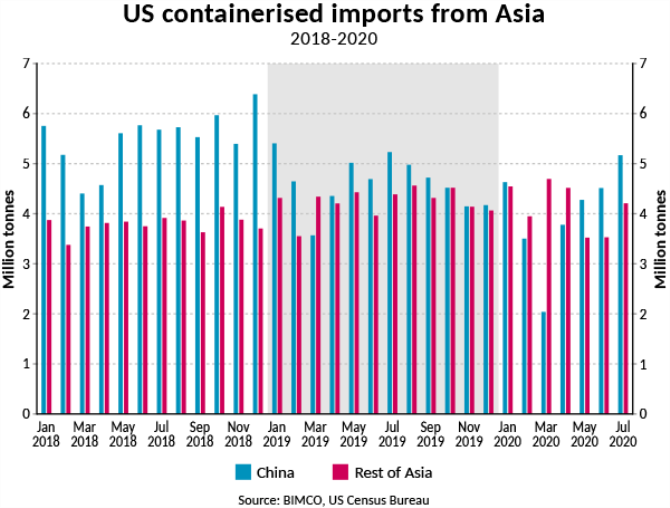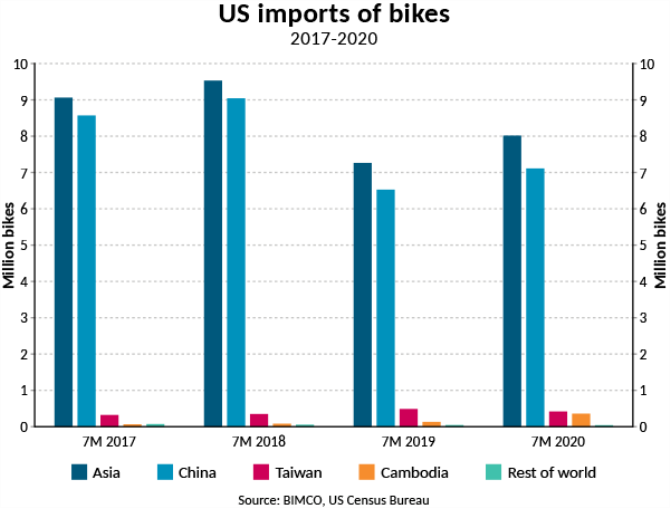US imports of bikes from China have fallen by 17% in the first seven months of 2020 compared with the same period in 2017, while imports of bikes from the rest of Asia have risen 83.1% though volumes from here remain much lower. In the first seven months of this year, the US imported 7.1 million bikes from China and 0.9m from the rest of Asia. Taiwan and Cambodia's exports have risen by 30.4% and 478% to 416,169 and 358,718 bikes, respectively.
In the first seven months of 2020, US containerised imports from Asia excluding China exceeded imports from China. If this continues in the remaining five months of the year, 2020 will be the first year ever to see this trend.

However, recent months blurs this picture as China has regained the top spot over its neighbouring countries. After falling sharply in March, containerised imports from China have recovered and are in July just 61,667 below levels in July 2019. On the other hand, imports from the rest of Asia did not experience the same sudden drop as imports from China but are also taking longer to return to pre-pandemic levels. These different timings of lockdown and pace of reopening means that in Q1, the US imported 3.0m tonnes less (-12.9%) from China than from the rest of Asia, whereas in Q2, China was ahead by 1.0m tonnes (+8.6%).
The trend of a narrowing of the gap between China and the rest of Asia really took hold in 2019, when the difference in imports narrowed to 4.7m tonnes, a marked decrease from the 20.4m tonnes in 2018. This changing pattern is testament to the shift in manufacturing that has been occurring in Asia for some time. The shift is not only driven by the trade war but also companies looking to move away from China as production costs have increased in comparison with many of its neighbours.
It also demonstrates the lack of proper growth in 2019 compared to 2018 in Chinese exports - one of the main drivers of global trade.
"Importantly for shipping, the US tariffs have not provoked a large-scale return of manufacturing to the US, leaving tonne mile demand relatively unaffected. As far as containerised shipping is concerned, whether a good is exported from China or Cambodia makes little difference in terms of distance."
“The high uncertainty that the tariffs provoked had reduced by the establishment of these new trade lanes, but the uncertainty has since once again sky-rocketed as a result of the pandemic," says Peter Sand.
Socially distanced, but with plenty of Christmas tree lights
The trend that was observed last year with the Christmas tree lights, which have faced tariffs since September 2018 when imported by the US from China, has continued this year. So far, imports of these goods are following their usual seasonality this year, rising sharply in July.
So far this year, the US has imported 31.5 million sets of Christmas lights, down 3.9% from last year, and compared to the first seven months of 2017, a 13.6% drop. The 13.6% drop has to be seen in the context that imports from China, which in the first seven months of 2017 accounted for 80% of US imports of Christmas tree lights, have fallen by 74.7%, whereas imports from the rest of Asia, and in particularly Cambodia, have risen by 215.3% and 197.8%.
This has caused a 50% rise in imports from Cambodia in the first seven months of the year, from a 14.3% rise in the first seven months of 2017. In contract, China’s share has dropped to 23.3% in the first seven months of this year.
In 2019, US imports of Christmas tree lights totalled 151.9 million sets, down from the record high 190.2 million in 2018, pushed up by frontloading ahead of the tariffs being implemented.
BIMCO has followed the trade war since it started, and this is the second analysis of individual commodities with more to follow as the story develops.
Source:BIMCO
The opinions expressed herein are the author's and not necessarily those of The Xinde Marine News.
Please Contact Us at:
media@xindemarine.com



 Baltic Exchange launches new Fuel Equivalence Conve
Baltic Exchange launches new Fuel Equivalence Conve  21 Consecutive Years of QUALSHIP 21 Recognition for
21 Consecutive Years of QUALSHIP 21 Recognition for  MPA and Wärtsilä Renew Partnership to Drive Marit
MPA and Wärtsilä Renew Partnership to Drive Marit  MPA and Dalian Maritime University Renew Partnershi
MPA and Dalian Maritime University Renew Partnershi  PSA INTERNATIONAL, DNV AND PACIFIC INTERNATIONAL LI
PSA INTERNATIONAL, DNV AND PACIFIC INTERNATIONAL LI  INTERCARGO Reaffirms Call for Simplicity as IMO Cli
INTERCARGO Reaffirms Call for Simplicity as IMO Cli